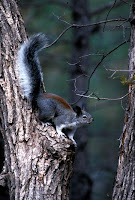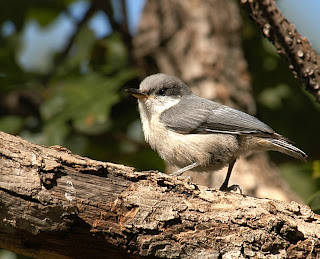 |
| Hairy Woodpecker, female |
 |
| Broad-tailed Hummingbird |
I'll tell you one story of a bird observation that encapsulates our fascination with birds and helps explain why we bother putting out seed, suet, nectar, water, nestboxes, and the like to see more of these amazing animals. It starts with the broad-tailed hummingbird. That's the hummingbird species which commonly breeds in our eastern Arizona forest, and is generally the first hummingbird species to come back to our mountains in the spring, migrating from southern Mexico or Latin America where they winter. It looks very much like the eastern U.S.'s ruby-throated, but isn't.
The first year we moved to our home, I started putting out hummingbird feeders. We got a few birds. But over time, we figured that they told four friends, and those friends told four friends, etc. etc. that this place in Lakeside is a happy place to be if you're a hummingbird. We continued to get more birds every year. So these feeders are up most of the spring, all summer, and into the fall until we're certain the last bird has flown the coop so to speak. I then pack away the feeders until spring.
But I'm never really certain when to start putting out the feeders in the spring. Usually I start when I hear the trilling wings of a broad-tailed. It goes like this: I'm doing something, working in the yard, knitting on the back deck, whatever, and I hear the hummingbird. The sirens in my mind go off: "They're here! Get the feeders out!!!" and I race into the kitchen, make some nectar, and hummingbird season is on. But here's the deal. That very first hummingbird--and every year, this happens, and remember, no feeders are hanging out yet--comes into the yard, and proceeds to hover in a little circle EXACTLY where a feeder USED TO HANG last summer. There's nothing there except air. Nothing to attract it to that spot. After leaving our house, migrating hundreds of miles to somewhere in Latin America, spending six months down there, migrating back, they manage to find our house, which is one thing. But to recall that this little space, this volume of air, used to be a feeding source--well, for a bird that barely weighs an ounce with an extremely tiny brain, that's pretty amazing. I personally am in awe, because I can barely find anything in my refrigerator, and I visit that thing every day.
 |
| Acorn woodpecker, foe of squirrel |
 |
| Mr.Squirrel |
Stories like that abound from our birds. I didn't know acorn woodpeckers really hate squirrels until I saw them fighting over peanuts. The woodpecker won, by the way. Most birds love our sprinkler system that turns on every morning to water our grass. Hummingbirds hover in the spray. Flickers love our ants (great, have at 'em). Pine siskins eat us out of house and home, every spring. A lone Cordilleran flycatcher sings in our trees every morning in the summer, but I've never seen two of them, just one. We have had nuthatches (both pygmy and white-breasted), western bluebirds, mountain chickadees, juncos, ash-throated flycatchers, and even violoet-green swallows nesting in our yard, either in nestboxes or in our trees or shrubs. One night, a friend (Randy Babb, who took many of these photos) of ours took an MP3 player and called in three western screech-owls. We've seen those owls nearly every year; late at night they come to our pond.
 |
| White-breasted nuthatch at a nestbox |
 |
| Our yard's Western screech-owl, the very one |
All these "dicky birds" are too tempting for our local hawks. Cooper's and sharp-shinned hawks make regular forays into our yard. Most of the time, they're not successful, but alas, sometimes they are. We've had a northern goshawk drink out of our pond, coincidentally on the morning of my 40th birthday. Bruce saw it first, pulled me from the shower (yes, shampoo in my hair) to see it, and proudly exclaimed "Happy Birthday!" It was a great present!
Another lesson learned from attracting birds to our yard: when you purposefully attract birds (vegetation for cover and food, water, ponds, feeders, suet, etc.), you also attract OTHER wildlife. Some you don't mind, like our common squirrel, the tassel-eared Abert's squirrel. Others you do: skunks (we have a dog, need I say more), raccoons (they destroy the pump in our pond), rock squirrels (they eat all our flowers, argh!!!), and...bears. Yes, we live on the outskirts of town, in a very low-density neighborhood, right next to the Fort Apache Reservation, a multi-million-acre expanse of forest. Wildlife move through, including bears. I could go on about bears, how it's mostly humans that attract bears, leaving out their garbage, and how my husband has to interact with the public, trying to make homeowners change their behavior and keep garbage and all food sources (including bird feeders!) in a locked garage/shed at night. I could go on. It's frustrating because people don't, or won't, change, and bears subsequently suffer. But we try to do our part, because if we don't (and we occasionally make a mistake early in the spring, when bears start moving around), we sometimes wake up to this:
| Front paw print of bear |
Or this:
| Bent feeder pole due to a bear visit |
Or, one morning, this:
We've learned to start putting in our feeders (all of them; seed and hummingbird) at night. Not much we can do about our pond or something like the above platform feeder, which is nailed down. We only put a handful of seeds on our platform feeders now, enough to just last the day.
Despite some angst over these unanticipated visits from various animals, we've learned that if we want one thing (i.e. birds), we have to settle for the occasional problem. You really can't have one without the other, and the sooner people accept that and work with it, I think the happier we all will be, including the skunks, raccoons, and bears.
So anyway, that's an introduction to our yard birds, and other critters that benefit from us feeding and attracting birds. I'll add more stories and observations as regular blog entries, but this should give you a background to the birds (and other critters) in our lives.
 |
| Pygmy nuthatch |
Photos of Abert's squirrel, acorn woodpecker, white-breasted nuthatch at nestbox, western screech-owl, and pygmy nuthatch courtesy of Randall Babb. Photos of hairy woodpecker and broad-tailed hummingbird courtesy of Bruce Sitko. Bear photos are mine.